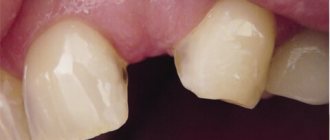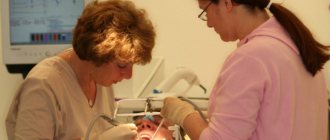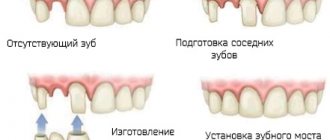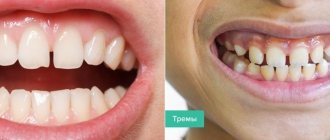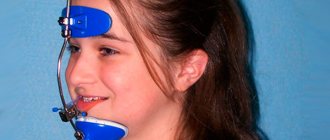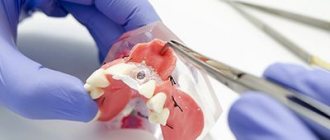8715
Today, it is possible to correct the bite or incorrect position of teeth in children of school and preschool age using a modern method.
The most common method is to use the domestic elastopositioner “Corrector”.
We will tell you what this device is, how effective it is, how to use it and much more in this article.
General overview
Elastic positioner “Corrector” is a silicone mouth guard designed to correct malocclusion in adults or children. It is also used for preventive purposes and during the retention period after wearing braces.
Due to its high elasticity and biocompatibility, one device can be used throughout the entire course of treatment.
The principle of operation of the elastopositioner is to soften the load on the teeth during their compression. It eliminates the pressure of intra-articular elements, resulting in improved articulation of the jaws and reduced tension in the masticatory muscles.
Correction of malocclusion using the elastopositioner “Corrector” is recommended at an early age (starting from six years), before the formation of the bite of the molars.
The best results can be achieved if it is used precisely during the period of change of temporary dentition.
Analogs
A silicone teeth corrector can be standard, that is, created at the manufacturer’s production facility. Each manufacturer offers a whole line or size range, as well as several modifications of elastopositioners, so that it is possible to select a device according to the clinical situation, age and individual parameters of any patient.
Let's list the most popular myofunctional correctors for teeth, which doctors classify as elastopositioners 2.
Trainer system Myobrace (“Myobrace”)
The most popular and effective trainers are produced by the Australian company MRC. There are many Myobrace series for literally all occasions. Some modifications involve the sequential use of two structures - a soft one at the initial stage of treatment and a more rigid one at the final stage. Let's list them:
- Infant series: for the youngest patients whose baby teeth are still emerging,
- T4K: This children's dental corrector is suitable for young patients 6–10 years old,
- T4A: Intended for teenagers.
Some series suggest a three-stage treatment system: Myobrace Juniors for children from 3 years of age and Myobrace for Adults for adult patients. In the process of correcting the bite, you will need to use three devices of different rigidity.
The Myobrace collection also includes elastic positioners that are used in conjunction with braces: T4B and Lingua.
There is also a preventative series - models i-2 and i-2N. They are available in three sizes - Small (for children 5-6 years old), Medium (suitable for those 6-8 years old) and Large (8-12 years old).
MRC also produces a series of elastopositioners myOSA 3, which are recommended for use in the treatment of temporomandibular joint dysfunction, snoring, bruxism and headaches.
Advantages over braces
Braces act in a narrow manner, widening the jaws for the normal positioning of teeth. Myobrace aligners have much more tasks. In addition to correct teeth alignment, it solves a number of orthodontic problems:
- getting rid of bad habits;
- tongue position correction;
- uniform distribution of chewing load;
- improper swallowing.
Aligner for the first stage of wearing
Bad habits that can be observed in a child include thumb sucking and mouth breathing. Elastic positioners help eliminate them, while increasing the tone of the muscles of the mouth and chin.
The main advantages of using the Myobrace system:
- tone the oral and facial muscles;
- widen the jaw for optimal teeth alignment;
- solve the problem of crowding in the frontal area.
After the examination, the orthodontist selects the optimal device from the Myobrace series. The size of the required mouthguard is determined by the width of the front teeth.
An important advantage will be the cost of such treatment, which is several times less than other options for correcting the bite. In addition, the use of elastopositioners does not have a detrimental effect on tooth enamel and the oral mucosa. Unlike braces, elastic aligners do not irritate the gums and do not lead to inflammatory processes. When using even expensive brace systems, you can sometimes observe exposure of the root part of the teeth and disruption of the enamel structure, which does not happen when wearing Myobrace elastopositioners.
Children's trainers
Design features
The device is a movable two-jaw apparatus, which is fixed in the correct bite position. It is attached to the lower and upper teeth and has the shape of a mouthguard.
The device forms optimal occlusion, and there is no separation of the jaws along the occlusal surface in different places.
Thus, defects in the occlusal line are eliminated, the incisors are aligned, as a result of which the load is distributed evenly throughout the jaw.
The design is made of medical silicone, which is elastic and durable. Distinctive features of the device:
- stable shape retention and color retention;
- high anatomical compatibility;
- absence of any odors;
- easy operation and maintenance.
The device includes buccal and lip pads and tongue shields . It fits comfortably in the mouth, thanks to special grooves for teeth that precisely follow the curve of the jaw arch. It has elongated palatal edges , which help expand the dentoalveolar line in the lateral regions.
An additional corrective component is the labial arch, which almost does not overlap the gums.
Enlarged breathing holes help the patient easily adapt to the device. The design is designed in such a way that the frenulum on the upper lip is absolutely not injured. This elastic positioner is suitable even for people with a low frenulum.
Indications
Unlike other elastopositioners, the “Corrector” is multifunctional. Most removable systems need to be changed at a certain stage of correction. This device is used in a single copy throughout the entire course of therapy.
A special fixation system allows you to change the location of the upper and lower parts of the mouthguard without changing the main structure.
The device is recommended to be used in the following cases:
- Severe incisal occlusion.
- Vertical malocclusions.
- Distal bite.
- A symptom of crowded teeth.
- Protrusion, retrusion - when some teeth are located behind the rest.
- Marked displacement of the lower dentition.
- Disorders of the temporomandibular joint.
- Snoring and sleep apnea syndrome (periodic cessation of breathing during sleep).
- Bad habits such as thumb sucking, improper chewing, reverse swallowing.
- Habitual mouth breathing in children.
- Stimulating the growth of the lower jaw.
- Preventive measures (the ability to leave a small amount of toothpaste or special products in the device).
- After orthodontic therapy, the elastopositioner is used as a retention device.
What are OrthoSnap aligners and what problems can be solved with their help.
Let's talk here about the features of Star Smile aligners.
At this address https://orto-info.ru/sistemyi-vyiravnivaniya-zubov/lechebno-profilakticheskie-apparatyi/treynerami-infant.html a detailed description of Infant trainers is offered.
What is an elastopositioner
Elastopositioner 1 is an elastic myofunctional device or dental guard made of elastomer or medical silicone.
Silicone teeth corrector retains elasticity for a long time, but at the same time has increased elasticity. The material from which the elastopositioners are made is hypoallergenic, does not cause discomfort, does not injure the gums and mucous membranes, but at the same time it affects not only the dentition, but also the jaw (normalizes its growth). Elastic positioners are always removable and, which is very important, double-jawed. That is, they represent a single structure that is fixed on both jaws at once and allows you to adjust their position relative to each other. You can see what the design looks like in the photo.
Why are structures called myofunctional?
A dental corrector such as an elastopositioner not only corrects bite pathologies, but also relieves the patient of the causes that provoked its violation, that is, from bad habits that contribute to dysfunction of the maxillofacial apparatus. For example, incorrect positioning of the tongue, incomplete closure of lips and mouth breathing.
Elastic positioners help strengthen and train the orbicularis oris muscle, eliminate dysfunction of the temporomandibular joint, help get rid of snoring and apnea, normalize sleep and speech, relieve pain and hypertonicity of the masticatory muscles.
When are bite correctors prescribed?
The problem of eliminating occlusion disorders is very acute at any age. Therefore, bite correctors are universal devices that can be used from the age of three until the end of life. The design is a non-removable device that is installed inside the oral cavity. The patient is in contact with the device for a full day. This provides a quick effect despite some slight discomfort while wearing.
Bite correctors are intended as the sole treatment method, as well as in combination with other intraoral appliances. The main indications for their use can be presented as follows:
- distal bite;
- lateral displacement of dental occlusion;
- consequences of injuries and operations;
- insufficient effect from braces or removable devices (trainers);
- activation of the growth of any jaw in combination with other devices;
- anomalies in the development and formation of the dentition.
The main purpose of fixed appliances is to correct distal occlusion. For this purpose, they are prescribed, depending on the model, during the period of mixed dentition or throughout life after changes in the facial skeleton. The main mechanism of action of the devices is the load on the lower jaw in order to reduce its prognathism. The principle of operation is mechanical, carried out due to the resistance force of the rubber rods of the device.
How much to wear
For the first 2 days you need to wear it as long as possible. Therefore, immediately after removing the edgewise system, performing professional hygiene, and remineralizing therapy, this device should be ready for use. Then they switch to a 4-hour daytime + nighttime mode. How long should I wear the positioner? The effect of its use as a final means of setting teeth ends after 3 weeks. Then, if it is used, it is as a removable retainer.
Types of bite correctors and their features
There are quite a few manufacturers of bite correctors. Each of them has its own installation and application features. However, the vast majority of devices are characterized by a mechanical type of effect on bone structures, and the possibility of use is determined only by a dental specialist. The most current devices used in modern practice are discussed below.
- One of the first to appear on the Russian market. It has a rather bulky telescopic mechanism. But it is quite convenient for severe cases of distal occlusion. Usually not combined with braces, but installed before they are prescribed as the first stage of treatment.
- Jasper Jumper. Manufactured by American orthodontics. It is based on a power spring, covered for convenience with a silicone shell. Universal for use, both on a full row of teeth and with partial removal of incisors. The main disadvantage is the possible breakage of the spring, which requires replacement of the entire device. The device is quite large and not very convenient for children.
- Twin Force. Produced by Orthoorganaizers. The device has a hinge mechanism. This fact causes a pronounced effect even without the use of an orthodontic ring. However, caring for the device is quite complicated, but the design implies good aesthetics while wearing.
- Released. It has a complex design, including locking rings with an anti-rotation mechanism and fasteners in the form of a carabiner. The device is universal for any type of bite and can be used in children, although it is often not superior to trainers in terms of efficiency. Able to protect the position of teeth, especially molars, without moving them to the side.
- SUS. At its core, it is a powerful spring that allows for unilateral bite correction. The corrector is convenient when it is necessary to level large gaps between teeth in the lower jaw without the use of braces.
This is interesting: Correction of fangs with braces - advantages and disadvantages of treatment There are
still quite a lot of correctors on the market from other manufacturers. However, in each specific case, the attending physician chooses the one that is optimal for a particular patient. Correctors are used less frequently for children, as they are worn for 24 hours, which can interfere with the formation of correct speech. Trainers that are removed at night are convenient for children.
Thus, the choice of a bite corrector is made only by a professional doctor based on the patient’s clinical data. Wearing a corrector is not very comfortable, but it allows you to speed up the process of obtaining an aesthetic result. If there are anomalies of occlusion, it is necessary to contact a dentist as soon as possible to decide on the possible installation of bite correctors.
Contraindications
“Corrector” is ideal for those patients who, for some reason, cannot or do not want to use non-removable structures (bracket systems, plates).
However, there are a number of contraindications. The device is not recommended for use by people with the following pathologies:
- excessive narrowing of the base of the dentition;
- deviation of the midline of the dentition (more than 3-4 mm);
- medial bite;
- pronounced rotation, palatal eruption of incisors;
- too open bite;
- otolaryngological abnormalities.
Price
The price of the “Corrector” is about 3,500 rubles. In addition to the price of treatment with the device, the cost of treatment includes consultation, selection of design by size, diagnostics, which is mainly radiography (orthopantomography, teleradiography, targeted image).
Oral sanitation may be necessary. Thus, in the simplest clinical case, the cost of complete treatment will be about 10 thousand rubles, which is several times cheaper than treatment with braces or aligners.
Advantages
In a short period of time, the Corrector became popular. This is due to the following advantages:
- Safety. The material from which the device is made is completely safe for the patient’s health.
- Convenient to use. The ability to wear the structure only at night reduces a person’s psychological discomfort.
- Saving time and money. Before using the Corrector, you do not need to make impressions or carry out preliminary fittings.
- Troubleshooting complex problems.
- Quick adaptation (due to anatomical shape).
- High impact resistance and good tactile properties.
Instructions for use and care
Only an orthodontist can prescribe the use of the device. To achieve the best effect, it is recommended to wear the product not only at night, but also during the day (12-14 hours a day).
But this does not mean that you will need to reduce the activity of your social life. You can choose the right time to use it yourself.
During the day, the device should be worn for approximately 2-3 hours, and the time can be divided into 15, 30 or 60 minutes. Then it must be worn throughout the night (the Concealer cannot be removed at night).
When using the elastopositioner, it is recommended to adhere to the following rules:
- breathe through your nose (to form a correct bite and develop the upper and lower jaws);
- pursing your lips during silence;
- relax your lips when swallowing, which will allow the incisors to be in the required position.
During the first days of using the corrector, patients sometimes feel discomfort, but over time it goes away.
Treatment can last from several months to two years, depending on the severity of the disease.
It is important to clearly and correctly follow the specialist’s recommendations regarding the use of the device in order to reduce the time it is worn.
The corrector should be washed daily with warm soapy water. It is enough to carry out disinfection once a week by immersing it in a solution with special means for caring for dental dental structures. The dry device must be stored in a special container.
Patient reviews
Myobrace was recommended to us by a pediatric dentist when he saw the problem of crowded teeth. We were already thinking about getting braces, so this alternative turned out to be very tempting. The correction course recently ended, which took 16 months. The problem has been solved, but now you need to wear another mouthguard for some time to consolidate the result. The child likes this treatment, he is not capricious and does not refuse to wear the trainer. Moreover, he wants to brush it himself and is very responsible about the health of his teeth.
Marina, 32 years old
I am 29 years old and I have a problem with a front tooth that protrudes a lot. The dentist offered 2 options - braces for 75,000 rubles and a trainer for 5,000 rubles. The choice seemed obvious, but the doctor also noted that in the second case there is no guarantee that the bite will be corrected. I read reviews on the Internet, asked my dentist friend, and still decided to take a risk and save money. I have been wearing these mouth guards for 9 months now and I am very pleased with the results. The tooth slowly moves into place, and at the same time I do not have to suffer with braces.
Olga, 29 years old
We corrected the bite of a 5-year-old child with the Myobrace system. We really liked the result. I had to wear a mouthguard for a little less than two years, which is the same as treatment with braces. It's amazing how you can achieve such a result in a relatively short time and at such a low cost. Now I recommend elastopositioners to all the young mothers I know.
Irina, 27 years old
I had to be a little disappointed in this miracle device.
Indeed, it is very economical and safe, but you have to wait a very long time for the desired result. My daughter had a mouthguard made 3 years ago, and they have already replaced it once because it was damaged. The teeth have changed their position somewhat, but this is not enough. We're still thinking about getting braces. Stanislav, 35 years old
Efficiency
The corrector is considered one of the most effective methods for treating dental disorders. Studies have proven that using this device it is possible to treat people with severe distal occlusion, deep incisal disclusion during bite changes and other defects.
According to statistics, 70% of patients achieved excellent functional and high aesthetic results, 20% received satisfactory results, and only 6.7% did not achieve the desired effect because they interrupted treatment.
The Corrector is most effective for correcting malocclusion in children during the period of teeth change.
Using the product will help avoid aggravation of diseases of the dental system, therefore, there will be no need for expensive orthodontic treatment with surgical interventions.
What Bynin's mouthguard looks like and indications for its use.
This material is dedicated to lm Activator trainers.
Here https://orto-info.ru/sistemyi-vyiravnivaniya-zubov/lechebno-profilakticheskie-apparatyi/treyner-t4k.html we will talk about the purpose of the blue T4k trainer.
Expert opinions
Most orthodontists agree that the elastopositioner is quite effective in the treatment, diagnostic and preventive areas.
Something to remember! Correct, and most importantly systematic wearing of the device completely eliminates or minimizes the severity of functional abnormalities even in severe clinical situations.
The video provides additional information on the topic of the article.
This is interesting: Correcting the bite surgically
Sizing
There are eight standard sizes for adults and children, each of which corresponds to the length of four incisors.
It is necessary to measure the length with a ruler along the center line of the vestibular surface of the upper and lower dentition.
Then the obtained indicators are summed up, and in accordance with a special table, the required size is selected.
As a rule, large sizes are used for patients with closely spaced teeth, small ones for patients with three teeth.
All sizes have a specific color marking, are stored in containers of different shades and are selected by a doctor in a clinic.

